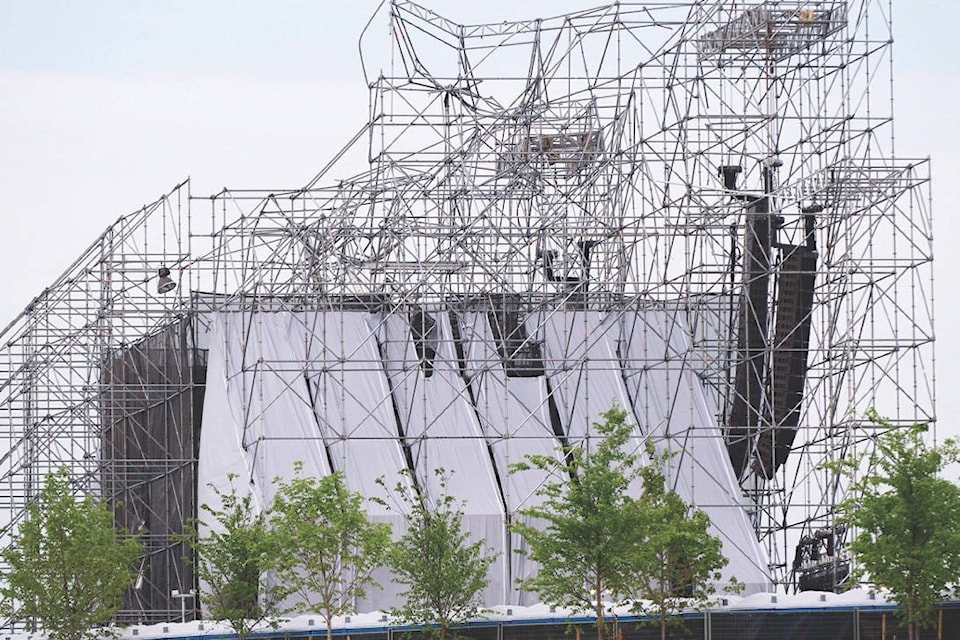TORONTO — Metal structures meant to hold a roof over a stage during a Radiohead concert in Toronto were the first pieces to fail as the entire setup came crashing down nearly seven years ago, killing the band’s drum technician and injuring several others, a coroner’s inquest heard Monday.
A Ministry of Labour engineer who helped investigate the collapse was among those who testified as the inquest into the death of Scott Johnson got underway.
Saeed Khoorsand said the pickup trusses bearing the weight of the roof grid — which itself held tens of thousands of kilograms in lighting and other equipment — were “the weakest link in the stage that caused the whole roof system to collapse.”
Khoorsand also pointed to some discrepancies between the plans and the materials used in building the outdoor stage, noting the trusses at the site weren’t as thick as they should have been according to the drawings, while some beams were larger.
The plans had been reviewed and checked by an engineer, Domenic Cugliari, just over a week before the incident, he said.
Johnson, who was Radiohead’s drum technician, was crushed by the falling roof and died just hours before the band was set to take the stage at Downsview Park on June 16, 2012.
Charges in the case, against Cugliari and others, were stayed because the matter took too long to get to trial.
The inquest, which is expected to hear from roughly 25 witnesses, will examine the circumstances around Johnson’s death, but will not assign blame. A jury may make recommendations aimed at preventing similar incidents.
“What happened to Scott was tragic but if we can’t learn from it … there’s no benefit at all from his death,” Prabhu Rajan, one of the lawyers assisting the coroner, said outside the inquest.
Rajan said he expects evidence will show some gaps in the current system. For example, he said, the concert was to take place on federal land, which meant there was no need to seek a building permit — a form of third-party oversight.
“I think that should give everybody some concern, some pause,” he said.
The inquest also heard Monday from a man hired to tune Radiohead’s pianos for the show, who said he heard the stage creaking in the wind shortly before the structure gave way.
Wayne Ferguson said he noticed it after a light breeze hit the stage’s back curtain around 3:30 p.m. or 3:45 p.m. and tried to see what was going on above them.
Ferguson testified that he was asked to leave the stage around 3:50 p.m. so that others could perform a soundcheck, but Johnson — who was stationed near him — stayed behind.
Ferguson and his daughter were sitting at a picnic bench facing the stage shortly afterward when there was a loud noise, he said.
“We heard a huge crack and within, like, two seconds the whole roof collapsed,” Ferguson told the inquest. He described seeing beams piercing through the back grid of the stage and immediately calling 911.
A paramedic who was one of the first at the scene testified he found Johnson trapped under the stage with no vital signs.
“There was nothing we could do for him, especially because we couldn’t extricate him,” Stephan Krasl said.
Johnson’s father and Radiohead’s drummer described the shock and grief they felt when they received the grim news, as well as the lingering trauma from that day.
Johnson’s family and the British band have been highly critical of the judicial process, but said they hoped the inquest would bring some of the answers they did not get through the courts.
“That causes me great concern that the case wasn’t completed,” Ken Johnson said. “It’s painful but I’m quite happy that events here will resolve all that.”
The band’s drummer, Philip Selway, testified that the incident was “personally traumatizing” for them and their crew, and made them feel “vulnerable” onstage.
Outside, Selway said he felt it was important to attend the proceeding.
“After all the charges were stayed, we had a real sense of injustice from it and nothing constructive, from our point of view, came out of that court case,” he said. “So we feel a responsibility to Scott, we feel a responsibility to Mr. and Mrs. Johnson, and our crew, and to our audience as well to keep pursuing this.”
Thirteen charges were laid under provincial health and safety laws against the show’s promoter, Live Nation, contractor Optex Staging and Cugliari, the engineer.
But the case went off the rails when the presiding judge at trial declared he had lost jurisdiction after being appointed to a higher court. Another judge declared a mistrial and a new hearing was planned.
Defence lawyers argued the charges should be stayed because the delays violated their clients’ rights to a timely trial, which was expected to wrap up in mid-2018, five years after charges were laid. The new judge agreed, noting the Supreme Court’s so-called Jordan decision, which set a ceiling of 18 months for proceedings in provincial court.
